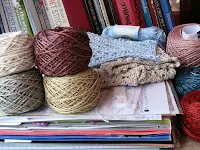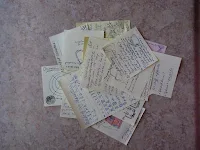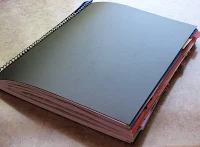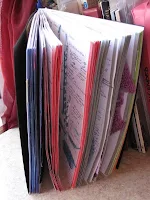 |
| New pdf format for my free crochet patterns |
My crochet patterns for "components" are included here--a flourishing pattern category in Ravelry for the building blocks of crochet projects. It's an important category because it's where a lot of the juicy bits of crochet can happen: cultural subtleties, skill refining, artful customizing, and creative problem-solving. Components are things like: stitch patterns, edgings, insertions, fastenings, appliqués, embellishments, afghan blocks, and miscellaneous tutorials. I seem to naturally enjoy designing these also, and have been putting them in my free biweekly Crochet Inspirations Newsletters.
A. Free Crochet Components (stitch patterns, edgings, insertions, fastenings, appliqués, embellishments, afghan blocks, miscellaneous tutorials, etc)
Why & How to Crochet Limpet Stitches & Half Hitches: Issue #3 of Vashti's Crochet Inspirations Newsletter, "A Very Different Kind of Crochet Stitch."
 |
| 3 Slim Foundation Stitches |
How to Do the Classic Single Crochet Version of the Double-Faced Stitch: Issue #6 of Vashti's Crochet Inspirations Newsletter, "Thick Enough Crochet (The 'Helena' Stitches)."
Twisted Front Loop Single Crochet (Twflosc): Issue #12 of Vashti's Crochet Inspirations Newsletter, "Twist Some Loops."
The Tunisian Yarn Over (Tyo), A Valuable Stitch to Know: Issue #10 of Vashti's Crochet Inspirations Newsletter, "Tunisian Crochet: Breaking Out of Ruts."
 |
| Twisted Loops |
The Speedy Offset Filet Stitch: How to Crochet It and Graph (aka Chart) It: Issue #4 of Vashti's Crochet Inspirations Newsletter, "Graphing Waterlilies."
The Popular 'Seed Stitch' and Elongated Sc Variation: How to Crochet It, and Graph (aka Chart) It for Colorwork: Issue #4 of Vashti's Crochet Inspirations Newsletter, "Graphing Waterlilies."
B. Free Crochet Patterns for Projects
Eva Scarf (see photo at top left corner of this post)
Scrappy the Draft Snake
This free pattern download is also a great example of how I publish my premium crochet patterns that you can purchase at DesigningVashti and in Ravelry.
Pampering Pebbles Makeup Removal Pockets: Issue #21 of Vashti's Crochet Inspirations Newsletter, "Wee Pebbly Stitches."
Two Simple Clasps for Crochet Jewelry: Wavy Donut Button and Plump Star Button: Issue #1 of Vashti's Crochet Inspirations Newsletter, "New Crochet Talk (Inaugural Issue)."
Beginner's Necklace Cord, and Spring Buds Cord, both in issue #17 of Vashti's Crochet Inspirations Newsletter, "Crocheting Fancy Cords."
C. Free Crochet Patterns for Kids and Their Parents at my ToyDesigningVashti Blog:
Glee Worms
The first free pattern I ever published as a blog post, in October 2006.
G. Lion Brand:Fancy Fur Kimono
Ravelry Design Page. (Ravelry page contains link which goes to the Lion Brand Yarn site, where you will encounter a sign-in page)
This free pattern download is a great example of how I publish my premium crochet patterns that you can purchase at DesigningVashti and in Ravelry.
http://www.ravelry.com/
The scarf was first published as Ribbed Slip Stitch 'Classico' Scarf in Issue #9 of Vashti's Crochet Inspirations Newsletter, "Slip Stitch for Style."
The scarf was first published as Ribbed Slip Stitch 'Classico' Scarf in Issue #9 of Vashti's Crochet Inspirations Newsletter, "Slip Stitch for Style."
 |
| Scrappy Posing as a Toy |
Scrappy the Draft Snake
This free pattern download is also a great example of how I publish my premium crochet patterns that you can purchase at DesigningVashti and in Ravelry.
Love Knot Embracelet
The most popular free crochet pattern of this blog! I'm looking forward to publishing it in the new and pretty pdf format that I created for my premium indie-published designs. (See Eva Scarf for an example.) Ravelry Design Page
The most popular free crochet pattern of this blog! I'm looking forward to publishing it in the new and pretty pdf format that I created for my premium indie-published designs. (See Eva Scarf for an example.) Ravelry Design Page
 |
| Cowl-Ready Stitch Pattern |
Start a Cowl in the Round (How to Crochet an Easy Cowl): Issue #5 of Vashti's Crochet Inspirations Newsletter, "A Fever for Crocheting Cowls."
Cowl-Ready Crochet Stitch Pattern #1, and Cowl-Ready Crochet Stitch Pattern #2: Issue #5 of Vashti's Crochet Inspirations Newsletter, "A Fever for Crocheting Cowls."
 |
| Pampering Pebble Pockets |
Two Simple Clasps for Crochet Jewelry: Wavy Donut Button and Plump Star Button: Issue #1 of Vashti's Crochet Inspirations Newsletter, "New Crochet Talk (Inaugural Issue)."
 |
| Spring Buds Cord |
Simple Jelly Yarn 'Braid': Issue #11 of Vashti's Crochet Inspirations Newsletter, "Spring Loaded Stitches."
C. Free Crochet Patterns for Kids and Their Parents at my ToyDesigningVashti Blog:
Glee Worms
 |
| Glee Worm Cousins |
http://toydesigningvashti.
Ravelry Design Page.
Ravelry Design Page.
Hippie Hemp Teacher's Bracelets
http://toydesigningvashti.
Ravelry Design Page.
Ravelry Design Page.
Book Bling Bungee
http://toydesigningvashti.
Ravelry Design Page.
Ravelry Design Page.
Tokyo Jacket
Renaissance Tunic
Ravelry Design Page.
Pattern page at caron.com.
Wire Hotplate Doily (June 2005)
Pattern page at caron.com.
E. Remember the original Crochet me online crochet magazine? Here are direct links to my two patterns in the archived issues:
Rosebud Shrug (March 2006)
 |
| Rosebud Shrug |
Rosebud Shrug (March 2006)
Wire Hotplate Doily (June 2005)
F. Berroco Knit Bits newsletter:
Java Jammie (a coffee cozy that replaces those cardboard sleeves.) I think of the pattern as a "stitch game." Published in the Berroco Knit Bits newsletter issue #142 (June 30, 2006); scroll to the end for story and link to updated pattern page. (For some reason, these two links no longer link to the original Knit Bits issue: Ravelry Design Page and berroco.com/exclusives.)
G. Lion Brand:
Ravelry Design Page. (Ravelry page contains link which goes to the Lion Brand Yarn site, where you will encounter a sign-in page)
V-Stitch Cocoon Shrug
Ravelry Design Page. (Ravelry page contains link which goes to the Lion Brand Yarn site, where you will encounter a sign-in page)
Ravelry Design Page. (Ravelry page contains link which goes to the Lion Brand Yarn site, where you will encounter a sign-in page)
I have plenty more free crochet patterns and I want to format them all into pretty pdf's when I can. I'll update this post as they happen, and of course let you know when I come up with an official database of all free DesigningVashti crochet patterns.












